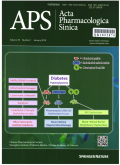- 钛学术文献服务平台 \
- 学术期刊 \
- 医药卫生期刊 \
- 药学期刊 \
- 中国药理学报(英文版)期刊 \
null
Learning of medical pharmacology via innovation:a personal experience at McMaster and in Asia
基本信息来源于合作网站,原文需代理用户跳转至来源网站获取
摘要:
Pharmacology in the traditional medical curriculum has been treated as a discrete "preclinical" discipline identifying itself distinctly different from the other preclinical sciences or clinical subjects in knowledge base as well as learning/teaching instructions. It is usually run in series with other pre-clinical courses (eg, anatomy, biochemistry,physiology etc), but in parallel with other paraclinical courses such as pathology, microbiology and community medicine. Clinical pharmacology was only introduced relatively recently designed to overcome the perceived deficiency in "preclinical" pharmacology regarding its therapeutic relevance and application to medicine. In many universities, both preclinical and clinical pharmacology courses co-exist, usually independently offered by two separate, sometimes non-interacting Departments of Pharmacology and Clinical Pharmacology. In this model,pharmacology is generally taught in a teacher-centered, discipline-oriented, and knowledge-based curriculum.Furthermore, pharmacology courses are commonly taught by "expert" teachers, who usually engage in excessiveteaching, often adopt a knowledge-based approach in both instruction and assessment, and frequently evade or ignore clinical relevance. The clinical relevance of the pharmacological sciences is sometimes also taught in a didactic and problem-solving manner, although it is usually case-oriented. In recent years, problem-based medical curricula have emerged, in varying forms, as a platform in which pharmacology is viewed as an integrated component in a holistic approach to medical education. In this problem-based learning (PBL) model, pharmacology is learned in a student-centered environment, based on self-directed, clinically relevant and case-oriented approach,usually in a small-group tutorial format. In PBL, pharmacology is learned in concert with other subject issues relevant to the case-problem in question, such as anatomy, physiology, pathology, microbiology, population health,behavior science, etc. Students learn via problem-evoked curiosity and motivation, in an environment which encourages free inquiries and intensive discussions in a cooperative rather than competitive atmosphere. Teachers facilitate students' learning objectives rather than deliver pre-packed knowledge and dictate what they think students should learn. Based on the above two models, a change towards PBL curriculum appears to be beneficial in better preparing the medical students as life-long learners capable of coping with changes in knowledge and skills associated with the progressive and dynamic social/economic transformation in the Asia-Pacific regions. Evidence is presented that this is indeed happening.

推荐文章
期刊_丙丁烷TDLAS测量系统的吸收峰自动检测
带间级联激光器
调谐半导体激光吸收光谱
雾剂检漏 中红外吸收峰 洛伦兹光谱线型
不同盐度、温度及光照对漂浮浒苔生理生态的影响
浒苔
盐度
温度
光照
生理生态
期刊_联合空间信息的改进低秩稀疏矩阵分解的高光谱异常目标检测
高光谱图像
异常目标检测 低秩稀疏矩阵分解 稀疏矩阵 残差矩阵
内容分析
关键词云
关键词热度
相关文献总数
(/次)
(/年)
文献信息
| 篇名 | Learning of medical pharmacology via innovation:a personal experience at McMaster and in Asia | ||
| 来源期刊 | 中国药理学报(英文版) | 学科 | |
| 关键词 | problem-based learning pharmacology medical education self-directed learning small group tutorial | ||
| 年,卷(期) | 2004,(9) | 所属期刊栏目 | |
| 研究方向 | 页码范围 | 1186-1194 | |
| 页数 | 9页 | 分类号 | |
| 字数 | 语种 | 英文 | |
| DOI | |||
五维指标
引文网络
引文网络
二级参考文献 (112)
共引文献 (42)
参考文献 (15)
节点文献
引证文献 (0)
同被引文献 (0)
二级引证文献 (0)
1990(1)
- 参考文献(1)
- 二级参考文献(0)
1994(2)
- 参考文献(2)
- 二级参考文献(0)
1997(2)
- 参考文献(1)
- 二级参考文献(1)
1998(1)
- 参考文献(0)
- 二级参考文献(1)
2001(3)
- 参考文献(1)
- 二级参考文献(2)
2002(1)
- 参考文献(0)
- 二级参考文献(1)
2003(5)
- 参考文献(0)
- 二级参考文献(5)
2004(8)
- 参考文献(0)
- 二级参考文献(8)
2005(4)
- 参考文献(0)
- 二级参考文献(4)
2006(4)
- 参考文献(0)
- 二级参考文献(4)
2007(5)
- 参考文献(0)
- 二级参考文献(5)
2008(8)
- 参考文献(0)
- 二级参考文献(8)
2009(17)
- 参考文献(1)
- 二级参考文献(16)
2010(9)
- 参考文献(0)
- 二级参考文献(9)
2011(11)
- 参考文献(0)
- 二级参考文献(11)
2012(22)
- 参考文献(4)
- 二级参考文献(18)
2013(8)
- 参考文献(2)
- 二级参考文献(6)
2014(6)
- 参考文献(0)
- 二级参考文献(6)
2015(2)
- 参考文献(0)
- 二级参考文献(2)
2016(2)
- 参考文献(0)
- 二级参考文献(2)
2017(6)
- 参考文献(3)
- 二级参考文献(3)
2004(8)
- 参考文献(0)
- 二级参考文献(8)
- 引证文献(0)
- 二级引证文献(0)
研究主题发展历程
节点文献
problem-based learning
pharmacology
medical education
self-directed learning
small group tutorial
研究起点
研究来源
研究分支
研究去脉
引文网络交叉学科
相关学者/机构
期刊影响力
中国药理学报(英文版)
主办单位:
中国药理学会和中科院上海药物研究所
出版周期:
月刊
ISSN:
1671-4083
CN:
31-1347/R
开本:
大16开
出版地:
上海市太原路294号
邮发代号:
4-295
创刊时间:
1980
语种:
eng
出版文献量(篇)
4416
总下载数(次)
2
总被引数(次)
42236
期刊文献
相关文献
推荐文献
- 期刊分类
- 期刊(年)
- 期刊(期)
- 期刊推荐
中国药理学报(英文版)2022
中国药理学报(英文版)2021
中国药理学报(英文版)2020
中国药理学报(英文版)2019
中国药理学报(英文版)2018
中国药理学报(英文版)2017
中国药理学报(英文版)2016
中国药理学报(英文版)2015
中国药理学报(英文版)2014
中国药理学报(英文版)2013
中国药理学报(英文版)2012
中国药理学报(英文版)2011
中国药理学报(英文版)2010
中国药理学报(英文版)2009
中国药理学报(英文版)2008
中国药理学报(英文版)2007
中国药理学报(英文版)2006
中国药理学报(英文版)2005
中国药理学报(英文版)2004
中国药理学报(英文版)2003
中国药理学报(英文版)2002
中国药理学报(英文版)2001
中国药理学报(英文版)2000
中国药理学报(英文版)1999
中国药理学报(英文版)1998
中国药理学报(英文版)2004年第9期
中国药理学报(英文版)2004年第8期
中国药理学报(英文版)2004年第7期
中国药理学报(英文版)2004年第6期
中国药理学报(英文版)2004年第5期
中国药理学报(英文版)2004年第4期
中国药理学报(英文版)2004年第3期
中国药理学报(英文版)2004年第2期
中国药理学报(英文版)2004年第12期
中国药理学报(英文版)2004年第11期
中国药理学报(英文版)2004年第10期
中国药理学报(英文版)2004年第1期

 免费查重
免费查重










